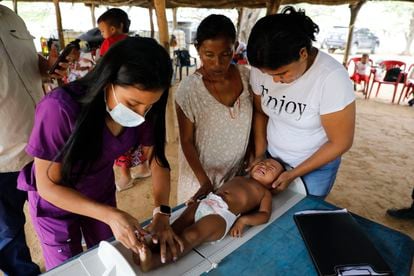EL PAÍS offers the América Futura section openly for its daily and global informative contribution on sustainable development.
If you want to support our journalism, subscribe
here
.
When a child stops eating, a life sentence begins.
The body turns on all the red lights and begins to eat "reserves."
Get rid of any traces of fat first, then the muscles.
The defenses disappear and at that time any disease can be fatal, from acute diarrhea to some respiratory complication.
Hunger is a body that eats itself.
So far this year, Colombia has lost 166 children under the age of five due to causes related to lack of food, according to one of the latest bulletins from the National Institute of Health.
More than one child a day.
In the entire previous year, there were 165. The main causes behind these worrying figures are poverty, violence and high inflation in the Andean country.
They tell him life in prison because the consequences never end.
Those who survive chronic malnutrition (a delay in growth due to little or no food intake from 0 to five years of age) do not, however, escape the echo of this disease.
“In the future, these children are going to have 14 points less IQ, five years less of schooling and 54% less income in their adult lives,” says Juan Carlos Buitrago, director of the Network of Food Banks of Colombia (Abaco ).
The expert points out five reasons why these figures are skyrocketing: poverty, migratory pressure, armed conflict, natural disasters and the crisis related to the war in Ukraine.
Hunger is not a new phenomenon in Colombia.
And the footprint of the covid has not helped either.
Colombian households that consumed three meals a day decreased from 90% before the pandemic to 70.9%, according to a recent Social Pulse survey by the National Administrative Department of Statistics (DANE).
At the beginning of the year, one in two Colombians was aware of food insecurity.
A nutritionist examines a Wayúu indigenous child in the Ishamana community, on May 14, 2022, in Maicao (Colombia). Carlos Ortega (EFE)
The territory also determines the future of childhood.
The geographic gap in the number of deaths from malnutrition is staggering.
The department of La Guajira is the most affected;
At least 49 children have died there in the last eight months.
There, specialists insist on mentioning the enormous underreporting that exists in the country.
“The doctors there tell us that for every child who dies in the hospital, there are two others who die in the communities without any statistics being recorded,” Buitrago points out.
He follows the Chocó, one of the most forgotten areas.
In this region of the Colombian Pacific, 19 minors have died in the last 223 days.
With 39% of the population living below the poverty line, Colombia has registered this month an inflation record for the last 22 years.
In addition, the country adds more than 4.9 million forcibly displaced by the armed conflict.
In this context, speaking of hunger as a consequence seems obvious.
For this reason, the main measure pointed out in the latest Action Against Hunger bulletin goes through the creation of opportunities for socioeconomic inclusion and formal jobs.
a hungry region
Both technicians are optimistic with the intention of the new Colombian Government to accelerate the second Sustainable Development Goal set by the United Nations, related to the eradication of hunger in the country.
Gustavo Petro has made this his main political flag.
“The time has come to be aware that hunger is advancing.
It is advancing around the world because an idea of food security based exclusively on international trade collapsed.
The world today learns the importance of food sovereignty.
Colombia is a country that should and can enjoy food sovereignty to achieve zero hunger”, he said at the inauguration.
For Buitrago, who is optimistic, the key is to put the magnifying glass on the structural: "I think Petro has put the issue on the table and we support his crisis plan, but in addition to the situation, we must tackle the underlying problems ”.
The situation in Colombia is not unique.
Of the 660 million people who live in Latin America, more than 60 million go hungry.
Another 220 million do not know if they are going to eat tomorrow.
The pandemic put a continent in check that, paradoxically, serves as a pantry for the rest of the globe, with 2020 being the year that the continent suffered the most food insecurity in the last two decades.
"And when we start to come out of a crisis, the war in Ukraine comes," laments Benedetta Lettera, director for Latin America of Action Against Hunger.
“I don't think it's a problem of lack of political will, but of capacity.
Robust funds and measures are needed to attack structural causes, such as violence or climate change,” Lettera explains by phone.
“We are facing a trend that worries us, the data gets worse every year.
But this is urgent, it is the priority of the continent”.

